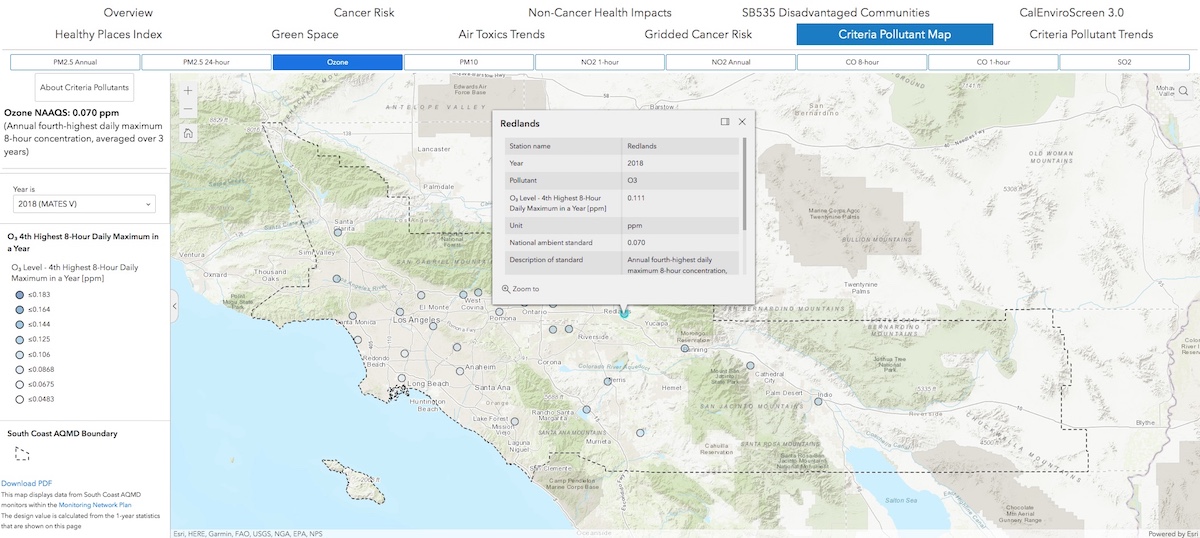Local Study - MATES

Multiple Air Toxics Exposure Studies (MATES) – Southern California Air Quality Management District (SCAQMD)
(Excerpts from MATES V Final Report)
In 1986, South Coast AQMD conducted the first MATES analysis to determine the Basin-wide risks associated with major airborne carcinogens. In 1998, a second study (MATES II) became one of the most comprehensive air toxics measurement programs conducted in an urban environment. A third study, MATES III, was conducted in the 2004-2006 timeframe. A fourth study, MATES IV, was conducted in the 2012-2013 timeframe. It consisted of a one-year monitoring program as well as updates to the air toxics emissions inventory and a regional modeling analysis of exposures to air toxics in the Basin.
The Multiple Air Toxics Exposure Study V (MATES V) is a monitoring and evaluation study conducted in the South Coast Air Basin (Basin) during 2018-19. The study is a follow up to previous air toxics studies in the Basin and is part of the South Coast Air Quality Management District Governing Board Environmental Justice Initiative. The MATES V Study consists of several elements. These include a monitoring program, an updated emissions inventory of toxic air contaminants, and a modeling effort to characterize risk across the Basin. The study estimates air toxics cancer risks using a risk assessment approach. Additionally, MATES V includes an exploratory analysis of chronic non-cancer health impacts (e.g. cardiovascular, respiratory, neurological health outcomes, etc.). The MATES analysis does not estimate impacts on mortality risk or other health effects from criteria air pollutant exposures; such analyses are instead conducted as part of the Air Quality Management Plans.
In addition to new measurements and updated modeling results, several key updates were implemented in MATES V. First, MATES V estimates cancer risks by taking into account multiple exposure pathways, which includes inhalation and non-inhalation pathways. Second, along with cancer risk estimates, MATES V includes information on the chronic non-cancer health impacts from inhalation and non-inhalation pathways for the first time.
The substances measured in MATES V are:
- Ultrafine Particles (UFPs)
- PM2.5
- Ions: Ammonium Ion, Chloride, Nitrate, Potassium Ion, Sodium, Sulfate
- Sugars: Galactosan, Levoglucosan, Mannosan
- Metals: Aluminum, Antimony, Arsenic, Barium, Cadmium, Calcium, Cesium, Chlorine, Chromium, Cobalt, Copper, Iron, Lead, Magnesium, Manganese, Molybdenum, Nickel, Phosphorus, Potassium, Rubidium, Samarium, Selenium, Silicon, Strontium, Sulfur, Thallium, Tin, Titanium, Uranium, Vanadium, Yttrium, Zinc
- Other PM2.5 mass, Black Carbon (BC), Elemental Carbon (EC), Organic Carbon (OC), Total Carbon (TC)
- Total Suspended Particulate (TSP)
- Metals: Antimony, Arsenic, Barium, Beryllium, Cadmium, Calcium, Cesium, Chromium, Cobalt, Copper, Cr6+ (hexavalent chromium), Iron, Lead, Manganese, Molybdenum, Nickel, Potassium, Rubidium, Selenium, Strontium, Tin, Titanium, Uranium, Vanadium, Zinc
- Volatile Organic Compounds (VOCs)
- Carbonyls 2-Butanone (Methyl Ethyl Ketone), Acetaldehyde, Acetone, Benzaldehyde, Formaldehyde, Propionaldehyde
- Other: 1,2-Dibromoethane, 1,2-Dichlorobenzene, 1,2-Dichloroethane 1,2-Dichloropropane, 1,3-Butadiene, 1,4-Dichlorobenzene, 2- Butanone (Methyl Ethyl Ketone), Acrolein, Acetone, Benzene, Bromomethane, Carbon Tetrachloride, Chloroform, Ethylbenzene, m+p-Xylene, Methyl tert-Butyl Ether (MTBE), Methylene Chloride, o-Xylene, Styrene, Tetrachloroethylene (Perchloroethylene), Toluene, Trichloroethylene, Vinyl Chloride
- Polycyclic Aromatic Hydrocarbons (PAHs)
- 9-Fluorenone, Acenaphthene, Acenaphthylene, Anthracene, Benzo(a)anthracene, Benzo(a)pyrene, Benzo(b)fluoranthene, Benzo(e)pyrene, Benzo(g,h,i)perylene, Benzo(k)fluoranthene, Chrysene, Coronene, Cyclopenta(c,d)pyrene, Dibenz(a,h)anthracene, Fluoranthene, Fluorene, Indeno(1,2,3- c,d)pyrene, Naphthalene, Perylene, Phenanthrene, Pyrene, Retene
The air toxics cancer risk continues to decline throughout the Basin with a 40% decrease in risk since MATES IV and an 84% decrease since MATES II, based on measurement data at the 10 fixed monitoring locations. The estimated Basin-wide population-weighted cancer risk calculated from the modeling data leads to a similar conclusion with a 54% decrease since MATES IV.
Diesel PM, while also substantially reduced from past MATES, continues to dominate the overall cancer risk from air toxics. The results from this study support a continued focus on the reduction of toxic emissions, particularly from diesel engines.
Further Reading
Guide prepared by P. Zannetti (1/2022). For corrections or expansions please contact us.